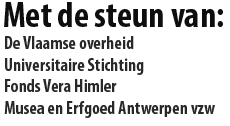A.K.L. THIJS
Vera Effigies? Vindingrijke omgang met drukvormen: productiekosten reducerende beeldmanipulatie bij bedevaartprenten
Vera Ogies? Creative engraving leads to cast reduction as well as to unauthentic imagery at holy pilgrimage sites
In the preindustrial era image manipulation enabled publishers to cut production costs by reusing printing blocks, even in a quite different context. They sometimes altered the image a litde bit and did not bother at all about violating the authenticity of the design. Evidence of this practice can be found in many kinds of cheap prints (chap books, almanacs, broadside ballads, etc) though rarely in images sold at pilgrimage sites. But by exploring the rather marginal phenomenon of this type of religious imagery new light can be shed on the position of the publisher and the pil-grim.
Because of the conditions in which the production and distribution of pilgrimage prints took place, image manipulation did not occur on a large scale. The local ecdesiastical administrators, who generally ordered the images, wanted to sell an accurate depiction of their holy site. The same can be said about the commercial publishers who were also active in well-known places with a guaranteed return. Thanks to this constant demand of the pilgrims, the (quite common) practice of using a printing block with a different context was rare.
The study of this (limited) number of special images does not allow to conclude that many pilgrims rejected these manipulated prints as fakes or considered these ‘misrepresentations’ as problematic, because their religious experience did not depend on the representations as such. What mattered for them was the belief in the special power they expected from these devotional prints. These `sacred’ images enabled pilgrims to make supernaturalism tangible in everyday life.
.
H. PIENA
Liefde uit Duitsland. Thüringer spanen dozen in de collectie van het Nederlands Openluchtmuseum
With Love from Germany. Chip wood boxes from Thiiringen (Germany) in the collection of the Dutch Open Air Museum (Arnhem)
The Dutch Open Air Museum houses a collection of about 250 chip wood boxes of varying origin. Recent research revealed that about 68 of these boxes were made in Th0ringen, Germany. They date from the end of the 18th century up until about 1900. Although these boxes are from different periods and differently decorated, they are remarkably similor in their production techniques. They all seem to have been made by splitting and planing long pieces of pine wood. The bottom and top boards are cut out and, if necessary, two boards are glued together to gain the required width. The sides are joined with willow twigs. The bottom and top boards are mounted with wooden pegs, the most recent examples being fixed with staples.
Initially these boxes were used as presents accompanying a wedding proposal. From the beginning of the 19th century the repertoire of decoration expanded covering mythological, heraldic, erotic and educational topics. From about 1830 onwards the painted decoration on the top was replaced by a lithography and the boxes predominantly served as containers for wooden toys.
Chip wood boxes were transported in huge quantities by boat and in the 18th century were already a well known item throughout the whole of Holland. They became a characteristic feature in Dutch households in all regions and social dasses. Their secondary use in Holland varied from the storage of important documents through to little household items and, most often, fragile textiles such as lace bonnets and rib-bons.
.
K. FRANCOIS en R. PINXTEN
Etnowiskunde: ontstaan en betekenisverschuiving van een concept
Ethnomathematics: Development of a Concept and its Shified Meaning
Ethnomathematics has no correlate in Dutch. Analogous to ethnomusicology – referring to the science of music around the world with the exception of so-called classical music – ethnomathematics could be considered to be the science of mathematica) thinking around the world, except for academie mathematics Indeed, at its inception ethnomathematics could be described in those terms. It was first and foremost developed within anthropology as the study of mathematica’ practices of illiterate peoples. Over the past decennia the concept was broadened, but it remained an important topic of research within anthropology. It now focuses on the study of mathematical practices in general, looked from the point of view of the group concerned.
In this paper we give an overview of emergence of the concept focusing on the shifts in meaning in it from an exotic and rather Eurocentric towards a postcolonial and intercultural approach to mathematical practices. Apart from that we investigate the areas in which ethnomathematics hos a potential impact: anthropology, history, philosophy, and of course mathematics education.
.

